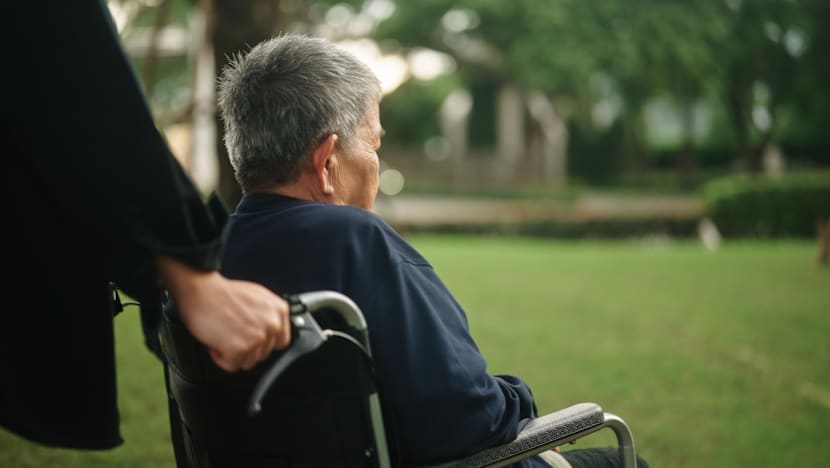Law passed to keep CareShield Life premiums sustainable; MPs debate affordability, fairness of insurance scheme
Amendments to the law include the reinstatement of a planned underwriting criteria and expanded avenues for the authorities to serve notices to defaulters of CareShield Life premiums.

An elderly woman on a wheelchair. (Photo: iStock)

This audio is generated by an AI tool.
SINGAPORE: Members of Parliament (MPs) passed a new law on Wednesday (Oct 15) allowing authorities to serve notices to defaulters of CareShield Life premiums, among other moves to keep premiums sustainable and affordable for those enrolled in the national disability insurance scheme.
Tabling the CareShield Life and Long-Term Care (Amendment) Bill for a second reading, Senior Minister of State for Health Koh Poh Koon said that while no one will lose coverage due to an inability to pay premiums, premium recovery is key to ensuring the sustainability of the insurance scheme and fairness to all policyholders.
“Like any other insurance scheme, CareShield Life relies on collective responsibility through risk-pooling within each cohort … As part of this collective responsibility, all policyholders must play their part by meeting their premium obligations,” he told the House.
Launched in 2020, CareShield Life provides monthly payouts for individuals with severe disabilities, defined as the inability to perform at least three out of six daily living activities, such as washing, feeding or dressing.
The national disability insurance scheme is compulsory for those born in 1980 or later, while older cohorts have the option to enrol.
The Bill also sought to reinstate the scheme’s underwriting criterion, which will lower premiums for older optional cohort policyholders.
A total of 14 MPs spoke in support of the Bill, while also raising various concerns about the amendments and other issues related to CareShield Life, such as its affordability and whether the insurance payouts are adequate for those with disabilities.
Targeted changes are proposed for CareShield Life to ensure it remains a robust and sustainable pillar of Singapore’s long-term care financing system. Senior Minister of State for Health Koh Poh Koon gave details in parliament on Wednesday (Oct 15). First, the planned underwriting criterion will be reinstated for Optional Cohorts - those born in 1979 and earlier - from 2026. This is after a concessionary period of four years which was meant to encourage enrolment. All Optional Cohort policyholders will benefit from the move because with the earlier concession, premiums had to be set higher to account for the possibility of people with mild to moderate disabilities being more likely to join the scheme. This risk will now be reduced. Currently, new Singapore Citizens and Permanent Residents in the same age range are also covered under CareShield Life if they are not severely disabled when they become citizens or PRs. From next year, this group can only enrol if they are not disabled. The second key change is to strengthen premium recovery processes. Demand notes will be able to be served to defaulters digitally, not just through physical letters.
WHAT THE BILL IS ABOUT
On the need to enhance premium recovery processes, Dr Koh cited how there are individuals “who can afford to, but wilfully decide not to pay their premiums despite repeated reminders”.
Premium defaults affect the scheme’s financial sustainability and in turn, the ability to meet claims. Consequently, such unrecovered premiums are shouldered by other policyholders within their cohorts in the form of higher premiums.
Currently, demand notes, which are formal notices served to defaulters, can be served through channels such as registered mail, but “operational challenges” emerge when policyholders fail to update their addresses or reside overseas, said Dr Koh.
The amendments would allow demand notes to be served via additional ways, such as digital means. This is similar to measures in place for recovery of MediShield Life premiums, and will streamline premium recovery actions, said Dr Koh.
Another change under the Bill is the reinstatement of an underwriting criteria for older individuals whose participation in CareShield Life is optional.
“Once insurance take-up is optional, underwriting is important. This is to guard against adverse selection, where those who are more likely to claim will be more likely to enrol, driving up claims,” Dr Koh said.
“Therefore, when the scheme was first conceptualised, it was designed such that only optional cohort individuals without any pre-existing disability could enrol in the scheme.”
But to ensure inclusivity, the Ministry of Health (MOH) granted a time-limited concession allowing older individuals to enrol in the scheme, even if they have milder forms of disability.
As of June, about 900,000, or almost half of the older optional cohort, have done so. Sign-up rates have dwindled over the grace period of four years - almost 90 per cent lower than when the scheme was first launched. This suggests that most older individuals who wanted to enrol in CareShield Life have already done so, said Dr Koh.
The Bill hence proposed reinstating the planned underwriting criteria for the optional cohort from Jan 1, 2026, alongside a new definition of “not disabled” as being able to perform all six activities of daily living without assistance.
This means that those from the optional cohort who have mild disabilities will no longer be able to enrol in CareShield Life.
Dr Koh said this change in underwriting criteria will moderate premiums for older policyholders, as the earlier concessions meant that premiums had to be set higher to account for the possibility that those with mild to moderate disabilities might be more likely to join CareShield Life.
For example, the annual premium for a policyholder born in 1952 will be lowered by more than S$100 (US$77.19) in 2026.
The change in underwriting criteria from January also applies to new citizens and permanent residents, meaning those who fulfil the “not disabled” definition will be eligible for CareShield Life.
WHY IT MATTERS
The passing of the law comes less than two months after changes to the scheme were announced in August.
The scheme had not been reviewed since its launch, and changes were recommended by an independent CareShield Life Council.
From 2026 to 2030, those enrolled in the scheme will see their premiums increase by an average of S$38 and up to S$75 annually.
The annual growth rate of CareShield Life payouts will be doubled from 2 per cent to 4 per cent, with the same eligibility criteria for claims.
“These increased payouts will better cushion against rising long-term care costs, driven by inflation of manpower and technology costs,” Dr Koh said.
With the new growth rate, a policyholder making a claim in 2030 will receive S$806 per month, compared to the S$731 per month under the previous annual growth rate. This is an increase of S$900 annually.
Under the revised scheme, the government has also committed to providing over $570 million in additional support over the next five years to help policyholders cope with the premium adjustments.
Of this sum, S$440 million will be used to moderate the premium increases for all affected policyholders, while the remaining S$130 million will be used to offer more support to low- to middle-income policyholders.
“Without this support, premiums in 2026 would have increased by approximately S$126 on average, with a 4 per cent per annum increase thereafter,” Dr Koh said.
The enhanced payouts and premiums will apply from 2026 to 2030 and will be reviewed after that, MOH previously noted.
WIDE RANGE OF ISSUES
While MPs on both sides of the House supported the Bill, they also raised concerns about a wide range of issues, including the affordability of the premiums, the scheme’s inclusivity and whether insurance payouts would be adequate.
Several also delved into Careshield Life premiums paid by women, who typically live longer and thus are more likely to develop severe disability.
Refining property annual value (AV) as a criterion for means testing for long-term care support is vital if Singapore policies are to keep pace with evolving demographic and caregiving realities. MP Jessica Tan said this in parliament on Wednesday (Oct 15). She voiced concern over the affordability of CareShield Life premiums, which are set to rise along with higher payouts. Specifically, she said retirees with modest assets but limited cash flow, who fall just outside means-tested thresholds, may struggle. This applies not just for CareShield Life but eligibility for other long-term care schemes too. Ms Tan asked if the Ministry of Health would consider tiering AV thresholds by age, adjusting the AV cut-off for older cohorts who own only one property; and taking into account the number of people requiring caregiving in a household, which would help support the sandwiched generation.
Similarly, MP Jessica Tan (PAP-East Coast) raised concerns about the affordability of long-term care for those who do not qualify for subsidy support, particularly retirees.
“These are often individuals who own modest assets but have limited cash flow, they fall just outside the means-tested thresholds, are caregivers for spouses or ageing parents, while managing their own health.”
MP Yeo Wan Ling (PAP-Pasir Ris-Punggol) and MP He Ting Ru (WP-Sengkang) spoke about the higher health and long-term care insurance premiums that women pay compared to men.
“Women pay higher premiums, and this is still the case, with the reasoning that women live longer and claim more,” Ms He said, asking if the assumptions that women would claim more and for longer have been borne out.
Ms He asked for more to be done to explore how the gender gap can be closed, citing that the longevity gap between men and women has narrowed over the last two decades. She suggested the possibility of a review of gender-based premiums.
On payouts, Ms Jaafar highlighted that the 4 per cent payout increase may not keep pace with actual long-term care cost inflation.
“And since the payout is also fixed at the point of claim or at age 67, their value may erode over time,” she said.
She asked if the government would consider regular affordability reviews to monitor premiums, subsidies, payouts and inflation, and recalibrate quickly as needed.
After the transition from ElderShield to CareShield Life, the next step is to ensure that CareShield Life remains true to its founding purpose - to stand beside every Singaporean in times of need, said MP He Ting Ru. Speaking in parliament on Wednesday (Oct 15), she said this means ensuring that premiums grow transparently and remain affordable. It also means that gender-based differences are regularly reviewed. Ms He also sought clarifications on the bill. She wanted to know more about the monitoring mechanisms and calculations that will help to give a better understanding of the adequacy of payouts. She also highlighted the issue of gender-differentiated premiums, saying that even if the actuarial reasoning and data make sense, actuarial fairness is not always the same as social fairness. She stressed the need to close the gender gap and aim for gender-neutral premiums.
Responding to MPs’ concerns about affordability, Dr Koh gave assurances that no one will lose CareShield Life coverage due to an inability to afford premiums.
He added that lower and middle-income policyholders will see even smaller premium increases, as they will enjoy further subsidies.
On questions on premium affordability for women, Dr Koh said gender is a “relevant factor” for CareShield Life as the key parameters that affect long-term care insurance claims, such as lifespan, duration and likelihood of disability, vary between men and women.
He added that women tend to live longer than men and are likely to develop severe disability, and are therefore more likely to stay in disability for a longer period.
“It will mean that in the event of severe disability, a woman will typically receive CareShield Life payouts for a longer duration.”
MPs also raised concerns about the underwriting criteria change and the impact on those excluded, such as older individuals from the optional cohort with mild disability.
MP Jamus Lim (WP-Sengkang) said while he understood the economic rationale of excluding those severely disabled, there remains a “moral responsibility” to take care of them.
In his response, Dr Koh noted that the optional cohort had been given a four-year concession period, with about 900,000 individuals, or about half of the optional cohort, enrolling in CareShield Life as of June.
Including those who chose to remain on ElderShield, about seven in 10 older Singaporeans are enrolled in national long-term care insurance schemes, he said.
ElderShield is an earlier version of the national insurance scheme against severe disability, and has since been replaced by CareShield Life.
Dr Koh said different layers of financial support, such as subsidies and grants, which have been “significantly enhanced recently”, are available for those who have chosen not to enrol in CareShield Life.


















